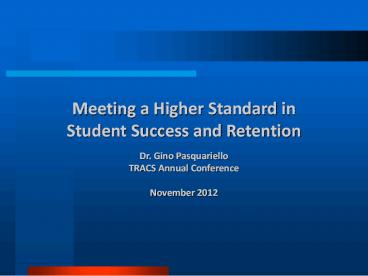A Comprehensive Model of Student Retention - PowerPoint PPT Presentation
1 / 18
Title:
A Comprehensive Model of Student Retention
Description:
Title: A Comprehensive Model of Student Retention Author: Gino Pasquariello Last modified by: ccrosswhite Created Date: 12/6/2006 1:04:01 PM Document presentation format – PowerPoint PPT presentation
Number of Views:226
Avg rating:3.0/5.0
Title: A Comprehensive Model of Student Retention
1
Meeting a Higher Standard in Student Success and
Retention Dr. Gino Pasquariello TRACS Annual
Conference November 2012
2
Defining Retention and Persistence
- Retention
- The ability of an institution to retain a student
from initial enrollment through graduation
(Unique student, annually typically
Fall-to-Fall) - Persistence
- The desire and action of a student to remain
enrolled in the program from beginning through
degree completion (term to term) - Progression
- Support strategies that provide students with
progression check points that are program and
year specific. - Completion
- The rate that indicates the percentage of
students that complete their degree program (100
, 150, and Over !50 of total degree length)
3
(No Transcript)
4
Models of Retention
- Interactionalist Model
- Student Entry Characteristics, Initial
commitment, and Academic and social integration
affect subsequent commitments to the institution
and the goal of graduation. - Institutional Experience Model
- A students persistence behavior is shaped by
their beliefs, and their beliefs are affected by
their experiences (Institutional Environment). - Student Involvement
- Higher levels of interaction and involvement
produce greater levels of institutional
commitment. - Student-Environment Fit Theory (Student
Satisfaction) - Congruence between student expectations and
institutional experiences, increasing student
satisfaction,
5
Theoretical Variables
- Major Factors and Revisions
- Variation according to Institutional Type,
Student Entry Characteristics, Academic and
Social Integration - The Impact of Environmental Factors on Adult
Student departure decisions - Major Psychological Dimensions
- Student Motivation (Internal and External),
Persistence (ability to face challenges and
overcome obstacles), and Self-Efficacy
(individuals perception of ability to succeed) - Economic Influences on Persistence
- Cost/Benefit Analysis, Ability to Pay and
Financial Aid
6
Six Primary Intersecting Persistence and
Retention Factors
- Entering Student Characteristics
- Initial Commitment
- Student Expectations
- Academic and Social Integration
- Institutional Experiences
- Student Satisfaction and Success
7
Exemplary Retention Initiatives
- Systematic and on-going assessment, evaluation
and implementation of retention interventions - Annual cycles of data collection, analysis, and
reporting - Identifying key areas for improvement
- Dedicated retention leadership, oversight and
management - Ongoing, timely and effective response (Best
Practices, Data-Driven) - Primary Institutional Commitments
- Emphasis on Core Distinctives and Student
Expectations - Constant promotion of student success (Early
Identification and Intensive and Continuous
Intervention) - Campus wide Involvement (Faculty involvement)
8
A Contextualized Approach
- While the goal of increasing student retention
may sound singular, the reality of the task is
quite multi-dimensional requiring us to ask
contextually specific questions
9
The Flow of Persistence
Student Entering Characteristics Currents of Resistance Experiences Currents of Persistence Experiences
Expectations Academic Ability Initial Commitment (Goal Orientation) Personal Relationships Ministry Commitments Work Commitments Tuition Costs Curriculum (Academics) Administration Relevance Connectedness Advising/Mentoring Purpose/Goal Alignment Degree Program Fit Motivation/Engagement
Student Assessment and Institutional Fit Initial Orientation, Advisement, and First Year Programs Ongoing Program Specific Goals, Support Development, Student Satisfaction
10
Core Institutional Assessment Instruments
- Entering Student Inventory (ESI)
- Seminary Experience Inventory (SEI)
- Graduating Student Inventory (GSI)
- Alumni Inventory (AI)
- Faculty Satisfaction Inventory (FSI)
11
Assessment Findings
- Student Engagement
- Active Learning Techniques
- Class Structure
- Emphasize Practical Application and Personal
Relevance in the course work - Meaningful, Guided Interaction
- Building Community and Connectedness
12
Assessment Findings
- Entering Student Inventory (ESI)
- 60 of new entering students are fulltime
students - There is a mix of age range and work commitment
- Students are active to very active in church
ministry - The schools doctrinal position is a strong
indicator of enrollment - Desire to serve and explore calling are high
priorities - Theological position was a key enrollment factor
- Most learned about SCS through a friend or the
website
13
Assessment Findings
- Decision to Attend (ESI)
- Comfort with the Schools Doctrinal Position
- Quality of the Faculty
- Academic Reputation of the School
- Quality of the Admissions Staff
- Close to Home/Work
14
Assessment Findings
- Pursuit of Theological Education (ESI)
- Desire to Serve God
- To Discern Gods Will
- Experienced a call from God
- Opportunity for study and Spiritual Growth
- Intellectual Interest in Theological Education
15
Assessment Findings
- Importance Items (SEI)
- Instructors demonstrate expert knowledge and
depth of insight - Instructors exemplify a deep faith commitment
- I am developing a deeper spiritual life and faith
commitment - I am learning valuable principles that apply to
my chosen field - The education that I am receiving is a valuable
investment of my time - The financial cost of my education is a good
investment - My educational experiences are relevant to my
current ministry - Instructors exemplify professionalism in the
classroom - Instructors provide timely and valuable feedback
on assignments
16
Strategic Actions and Recommendations Increasing
the Flow of Persistence
- Retention Initiatives
- Improved Academic Advising
- Simplified the administration of the Internship
Programs and increased value - Provided Faculty Development on Instructor
Feedback and Active Learning techniques - Improved Academic Support Research and Writing
Skills and Study Skills/Time Management - Increased Sense of Community (Communication and
Connectedness)
17
Strategic Actions and Recommendations Increasing
the Flow of Persistence
- Institutional Practices
- Employ Authentically Engaged Personnel
- Establish institutional persistence, progression
and retention goals and tracking - Develop program specific progress checkpoints
- Implement First Year co-curricular support
programs - Develop a documented system for timed-out student
follow-up
18
Contact Information
- Blessings and Thanks!
- Dr. Gino Pasquariello
- Dean of Student Services and Institutional
Research - Southern California Seminary
- El Cajon, CA 92019
- Office 619-201-8965
- Cell 619-804-0990
- gpasquariello_at_socalsem.edu

